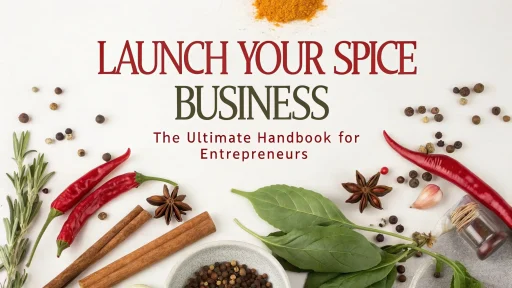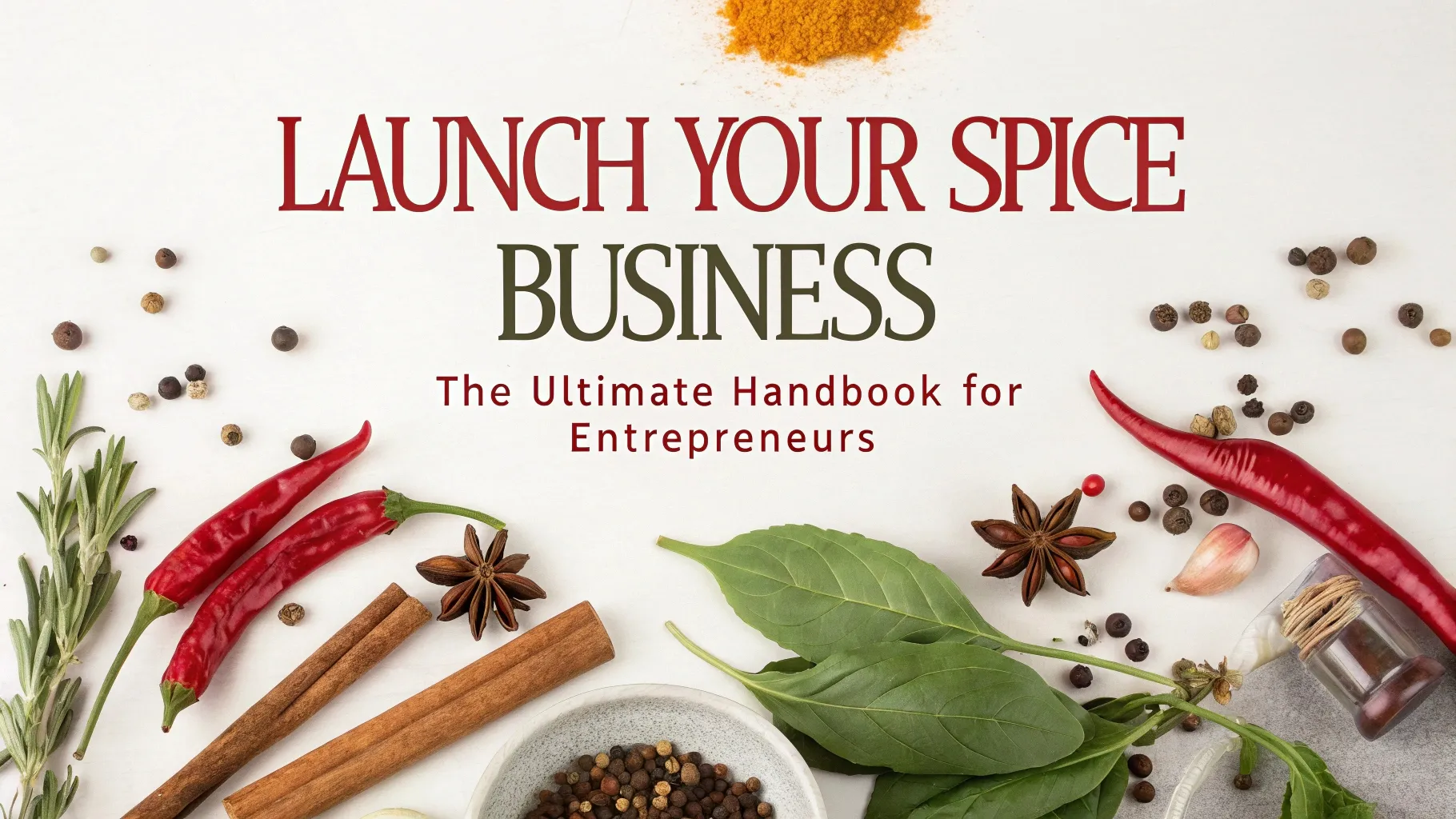Spices business have driven global trade for centuries, shaping empires, cuisines, and economies. Today, the spice industry stands as one of the most vibrant sectors within global agribusiness. The growing appetite for ethnic foods, wellness-based products, and organic ingredients has created a surge in spices business demand across the planet. Market Data Forecast puts the 2023 value of the global spice market at 24.8 billion U.S. dollars, with an expected climb to 39.4 billion by 2032—a compound annual growth rate of 5.25 percent.
In this growing landscape, new entrepreneurs see an open door. Low startup costs, the ability to scale up gradually, and strong export incentives all point to spices as an attractive first or next venture. NIIRs Handbook on Spices, Seasonings, Condiments, Processing & Extraction steps in here, giving clear, step-by-step advice from the first idea to shipping products around the world.
Why the Spice Business is a Smart Investment
The spices business trade is old—but its appeal has not faded, and experts believe it will not fade soon. Because spices have long shelf lives, they can be stored, shipped, and sold around the globe with far less worry than many other foods. They fit into so many markets—food and drink, cosmetics, medicine, and wellness—that a dip in one area is usually balanced by strength in another. That built-in spread of customers helps keep spice businesses steady, even when the economy takes a turn for the worse.
Health-conscious shoppers today are leaving artificial ingredients behind, so clean-label, preservative-free spice blends are flying off the shelves. Drinks like turmeric lattes, spicy chili oils, and small-batch masalas show how regional tastes can travel the globe, sparking a flavor Renaissance. Entrepreneurs who offer clean, traceable, and well-packaged options are stepping right into this growing lane.
India remains the world’s spice powerhouse, growing over 75 percent of every seed, pod, and powder shipped overseas and earning more than $4 billion from exports each year. Because of this rich heritage, small-business owners on the subcontinent can build quality-driven, value-added brands that proudly carry their homeland’s name.
Overview of the NIIR Spices Business Handbook
The NIIR Spices Business Handbook stands out as the go-to guide for anyone looking to start or grow a spice company. Unlike broad, one-size-fits-all manuals, this book zooms in on the nuts and bolts that matter to manufacturing entrepreneurs. Inside, readers will find:
- Step-by-step processing techniques
- Ready-to-use recipes for blends and sauces
- Detailed lists of equipment and suppliers
- Clear paths for regulatory approvals
- Practical budgets and return forecasts
- Inspiring examples from real businesses
With this organized layout, you can move from your first idea to an export-ready product without getting lost. The NIIR handbook is more than reference material; it is a hands-on partner on your spice journey.
Grab your copy today and kick off your spice business
Deep Dive: Spice Processing Techniques
Every great spice blend starts with careful processing, and getting those first steps right sets the stage for quality. This chapter kicks off with a look at both old-school and machine-made drying. That step is especially important for colors and oils in turmeric, paprika, and similar spices. Readers learn how solar drying, drum dryers, and simple tray setups differ in speed, power use, and end result.
Grinding follows, with a heavy focus on the size of the final grain, mesh grades, and keeping heat low. Spices like black pepper or clove can lose their kick if ground the wrong way, so the guide shows how each should be treated. It even brings in cold-grinding gear so the smell and fragile oils stay locked in.
On the high-tech side, the book explores steam distillation and solvent methods for pulling out spice oils and oleoresins. Those concentrated extracts can lift profits, especially with buyers in cosmetics and health products. Along the way, entrepreneurs find lists of equipment, typical yields, and safety tips that guard against contamination.
Manufacturing of Kitchen Spices
Store-bought kitchen spices make up the biggest chunk of spice sales worldwide. To tap into that market, the book walks new business owners through moving from hand grinding to semi or full automation. One clear example shows how a turmeric line grows when belt conveyors, hammer mills, and rotating sieves are added step by step.
Keeping the flavor, color, and moisture of spices steady is a must for any spice maker. To fight moisture, the guide suggests storage with silica packs and replacing air with an inert gas. It also looks at batch-tracking and vacuum sealing, so each bag upholds the promise on your label.
Related: Extraction of Curcumin from Turmeric
Essential Knowledge on Spices & Seasonings
Knowing what each spice actually does is vital for building a winning blend. The guide dives into more than 40 spices, noting where they’re grown, what they contain, and how to keep them fresh. Readers learn about turmeric’s antioxidants, the heat scale of different chilis, and how mustard helps mix oils and water.
The book also walks through blending tricks. It shows how dry herbs’ oil absorption can change flavor strength, and why salt pulls moisture that can shorten shelf life. With these facts in hand, small businesses can move past guesswork and create steady, repeatable mixes.
Mastering Condiment and Seasoning Formulation
Condiments open the door to fun new products. The guide gives step-by-step recipes for dry rubs, wet pastes, vinegar sauces, and even fermented blends. It stresses pH checks, good microbes, and picking the right pack—whether a plastic squeeze bottle or a vacuum jar—so that the customer enjoys every drop.
A large part of the process goes into getting the basic tastes just right—heat, salt, sweetness, and umami—so the product works for many different eaters. New makers are urged to think outside the box, maybe stirring in superfoods such as moringa or chill-with-me herbs like ashwagandha, and turning familiar condiments into something fresh.
Raw Material Sourcing & Quality Control
The grade of every spice that leaves the factory will make or break the brand. The guide walks would-be founders along India’s spice highways, from Gujarat’s cumin fields to Kerala’s cardamom hills, while pinning down the best pick-and-dry seasons for each crop.
To keep standards high, it lays out yardsticks like ASTA cleanliness scores and ISO 22000 food-handling rules. Testing for hidden dangers such as pesticide leftovers, heavy metals, or sneaky germs is covered, naming tools like gas chromatography and light-based spectrophotometry that labs often rely on.
Vendors also get a close look through checklists, plus contract-farming models that build traceable, steady quality over every harvest.
Food Safety & Regulatory Frameworks
No spices business can sleep easy if food safety is treated as optional. The book shows step-by-step how to set up a HACCP plan, putting a protective guard in place from the moment goods are bought until they hit the customer’s door.
Navigating Regulatory Standards
Global agencies set rules that can sound like a foreign language. This guide breaks it down using everyday examples so you know exactly what each agency wants. FSSAI (India), FDA (USA), and EFSA (EU) policies on things like synthetic food colors or ethylene oxide in dried spices are laid out in plain terms, along with sample label wording. Packaging rules—mandatory ingredient lists, allergen warnings, and best-before dates—get similar step-by-step treatment.
Branding and Product Packaging for Impact
Your jar or pouch starts the conversation long before anyone pops a lid. The book talks about using sturdy, eye-catching materials: clear PET jars for powders, matte stand-up pouches with zip seals for spice blends. It looks at how barriers, UV blocking, and tamper-proof seals work together and how they look on the shelf.
Branding goes deeper than color. Naming, logo placement, font mood, and clean nutrition labels all send signals. Founders are urged to weave a small story—whether it’s heritage, grandma’s recipe, or a special health boost—into the brand.
Marketing Your Spices Business Effectively
Marketing isn’t just shouting louder; it’s finding the right turf. The guide offers tailored moves for every budget. Shoestring brands can rent a table at a farmers market, slip samples to neighborhood grocers, or throw a small demo in their kitchen. Mid-range labels can use print ads, local radio bites, or boost posts on social media that showcase everyday uses.
Its pages urge spice makers to create a catchy Unique Selling Proposition, like No MSG, 100% Organic, or Ayurvedic Spice Mix. The book also steps into export branding, showing how to present Indian spices in Europe or America by highlighting their purity, rich history, and health benefits.
Costing, Pricing & Profit Margin Analysis
It’s easy to overlook real costs, yet without a precise number, profit becomes little more than a guess. The handbook walks readers page-by-page through workbooks that track both fixed and variable expenses, from spread-out machinery costs and power bills to packaging materials, transport, and wages.
It also breaks down three popular pricing styles—cost-plus, value-based, and penetration—showing readers when each is best. On top of that, new owners learn how to figure their break-even point, measure gross margin, and calculate return on investment.
Check our projects for more brief information
Setting Up a Spices Business Processing Unit
Planning a plant starts with picking the right land, then moves through drawing a factory layout, and finally pieces together a smooth workflow. The guide flags smart space use, separate zones for raw and packed spices, and design tips that keep every corner clean.
Later chapters zero in on equipment, listing ribbon blenders, impact mills, rotary sifters, and air lines with their speeds and power needs. It even gives cost ranges and typical install times, letting readers sketch a business plan or present clear numbers to investors.
Exporting Spices Global
The guide explains step by step how to register with APEDA, get phytosanitary stamps, and keep traceability logs that overseas buyers and customs want to see.
Spice Import Markets and Operations Basics
The handbook starts with a clear overview of the biggest spice business import markets: the U.S., Germany, the U.A.E., and the U.K. For each market, it lists top-selling spices and explains rules all sellers must follow. Entrepreneurs also get easy-to-understand guides to Incoterms, freight forwarding, customs duties, and local labelling laws that keep shipments moving and profits growing.
Case Studies of Successful Spice Entrepreneurs
Nothing teaches like a good story, and the book delivers plenty. Readers will meet home cooks who turned small jars of spice blends into seven-figure brands. By spotlighting lean startup methods, digital marketing, and creative flavour ideas, these case studies show that the playbook inside really works.
How the Handbook Accelerates Business Setup
Time and accuracy matter more than ever for new founders. This guide cuts down costly trial-and-error by sharing tested formulas, step-by-step processes, and ready-to-use business models. Whether validating a fresh idea, pitching investors, or launching an export line, you will find the tools and confidence to move fast and get it right.
Conclusion: Turn Knowledge into Profit
In the dynamic spice trade, good plans mean little without action. NIIR’s Handbook on Spices, Seasonings, Condiments, Processing & Extraction gives you everything needed for a thriving venture. By blending industry know-how, clear technical detail, and proven tactics, the book turns ambition into profit—quickly, sustainably, and tastefully.







